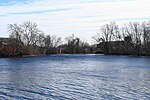Elliottville Lower Mill
1850 establishments in ConnecticutBuildings and structures in Windham County, ConnecticutCotton mills in the United StatesIndustrial buildings and structures on the National Register of Historic Places in ConnecticutIndustrial buildings completed in 1850 ... and 2 more
Killingly, ConnecticutNational Register of Historic Places in Windham County, Connecticut

The Elliottville Lower Mill, also known historically as the Peep Toad Mill, is an historic cotton mill in the East Killingly section of Killingly, Connecticut. Built about 1850, it is a well-preserved example of an early wood-frame textile mill. The mill complex, which includes, a dam, pond, head race, and bridge, was listed on the National Register of Historic Places in 1982.
Excerpt from the Wikipedia article Elliottville Lower Mill (License: CC BY-SA 3.0, Authors, Images).Elliottville Lower Mill
Peeptoad Road,
Geographical coordinates (GPS) Address Nearby Places Show on map
Geographical coordinates (GPS)
| Latitude | Longitude |
|---|---|
| N 41.839166666667 ° | E -71.8425 ° |
Address
Peeptoad Road 41
06241
Connecticut, United States
Open on Google Maps










